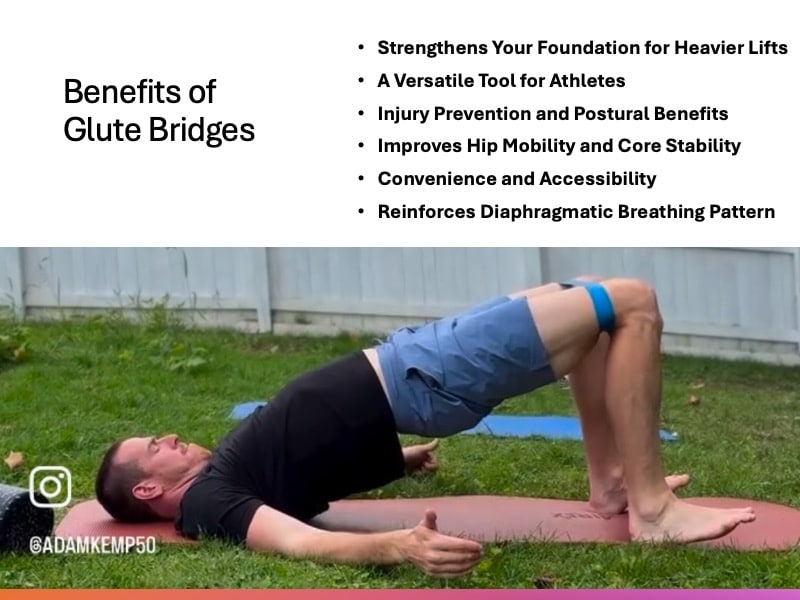Glute Bridge Benefits & Best Glute Bridge Variations
Whether you’re an athlete aiming for explosive power or a new trainee striving for better posture and core strength, the glute bridge and its powerful variations, including the single-leg glute bridge, deliver incredible benefits.
More than just a glute activation drill, this foundational movement plays a critical role in enhancing posture, lower-body strength, core stability, and overall movement efficiency.
Strengthening your glutes, hamstrings, and lower back not only improves athletic performance but also reduces the risk of lower back pain and injuries—a common issue for athletes and active individuals.
Whether you’re looking to sculpt your glutes, prevent injuries, or increase athletic power, the glute bridge is a must-have in your training arsenal.
Keep reading to discover the best glute bridge variations and how to incorporate them into your routine for maximum strength and performance gains!
Benefits of Glute Bridges

Overall, there are many benefits of doing glute bridges and glute bridge variations.
This seemingly simple movement, when executed in its various forms, can significantly enhance lower body strength, improve athletic performance, and contribute to overall physical health.
With its multiple variations and benefits, the glute bridge is an indispensable exercise for athletes and strength trainers alike.
Whether the goal is to enhance athletic performance, increase strength for specific lifts, or improve overall physical health, the glute bridge provides a comprehensive solution.
By incorporating this versatile exercise into training routines, athletes and fitness enthusiasts can unlock a higher level of physical capability and performance.
Strengthens Your Foundation for Heavier Lifts
For those aspiring to increase their prowess in back squats and deadlifts, the glute bridge is a game-changer.
A study conducted at Southern Utah University revealed that incorporating Glute Bridge Variations (GBV) in a standard Resistance Training (RT) program yielded superior improvements in lower body power production compared to programs including Supine Leg Curls (SLC).
This finding underscores the effectiveness of GBV in enhancing the foundational strength required for heavier lifts.
A Versatile Tool for Athletes
Unlocking peak athletic performance and building a resilient, injury-resistant body starts with mastering posterior chain exercises—and few are as effective as the glute bridge.
Glute bridges are one of the best exercises for basketball players like myself, and athletes participating in sports such as soccer, football, and baseball can also greatly benefit from them.
According to insights from the Strength & Conditioning Journal, the single-leg glute bridge, in particular, is instrumental in activating the posterior hip musculature.
This activation, coupled with the stabilization of hip abductors and core muscles, is critical for lateral stabilization and explosive linear movements.
These attributes are essential across a spectrum of sports, aiding in performance enhancement and injury prevention.
Injury Prevention and Postural Benefits
Glute bridges play a crucial role in balancing muscle strength and providing joint stabilization, especially in the hips and knees.
This balance is key in reducing the risk of injuries, which is paramount for athletes who engage in high-impact and high-intensity activities.
Furthermore, the strengthening of the glutes and core muscles through these exercises contributes to better posture, an essential element for efficient performance and injury avoidance.
Improves Hip Mobility and Core Stability
The varied nature of glute bridge exercises allows for targeted training, improving hip mobility and enhancing core stability.
These aspects are vital for athletes, as they facilitate a broader range of movement and maintain a strong and stable torso, respectively.
Improved hip mobility translates into more dynamic and fluid movements on the field or court, while a stable core forms the backbone of all athletic movements.
Convenience and Accessibility
One of the most appealing aspects of glute bridges is their simplicity and minimal equipment requirements.
They can be seamlessly integrated into various training routines, making them a practical and effective exercise for both gym-based and at-home workout sessions.
Reinforces Diaphragmatic Breathing Pattern
Proper execution of the glute bridge exercise reinforces diaphragmatic breathing, improving endurance and stamina.
The Best Glute Bridge Variations
Here are the best glute bridge variations that you should do once you have mastered the traditional glute bridge:
Mini-Band Glute Bridge
In this simple glute bridge variation, a resistance band is placed just above the knees.
As you perform the bridge, the resistance band encourages you to push your knees out, thus engaging the gluteus medius and minimus along with the gluteus maximus.
It is not much more difficult than the traditional glute brdige, but the miniband adds some increased resistance for your glutes.
Single-Leg Glute Bridges
Once you have mastered the traditional glute bridge and mini-band glute bridge exercise, the next variation you should try is the single-leg glute bridge.
This variation is slightly more difficult, but it is great because it will treat imbalances between each of your legs.
If one of your legs is stronger than the other, doing single-leg glute bridges will help even them out!
You can continue to increase the difficulty of the single-leg glute bridge by elevating your heels or doing some adduction/abduction work with your non-working leg.
Physio-Ball Glute Bridge
Once you have mastered both the traditional and single-leg glute bridge, the next step is to try some more advanced glute bridge variations.
For example, this physioball glute bridge with an in and out motion.
This is a great way to “bulletproof” your hamstrings!
Weighted Glute Bridge
For added intensity, you can perform weighted glute bridges with a barbell, medicine ball, or dumbbell placed on your hips.
This increases the resistance, making the glutes and hips work much harder to lift and lower the hips.
Heels-Elevated Glute Bridge
In this variation, your shoulders are placed on an elevated surface (like a bench or step) while your feet remain on the ground.
This increased range of motion allows for a deeper stretch at the bottom and a more intense contraction at the top of the movement, engaging the glutes more effectively.
Final Thoughts: Are Glute Bridges Effective?
Absolutely!
Glute bridges are one of the most effective posterior chain exercises for building lower-body strength, improving athletic performance, and preventing injuries.
Whether you’re an athlete seeking explosive power, a gym-goer looking to sculpt your glutes, or someone aiming to reduce lower back pain, this simple yet powerful movement delivers exceptional benefits.
By activating the glutes, hamstrings, core, and lower back, glute bridges help improve posture, stability, and overall movement efficiency. Plus, their versatility allows them to be modified for different fitness levels—from beginners to elite athletes.
If you want to maximize glute activation, core engagement, and overall strength, incorporating glute bridge variations into your training routine is a smart move.
Consistency is key, so make these a staple in your workouts to see real improvements in performance, strength, and injury prevention.
Read Next: Banded Monster Walk Exercise



